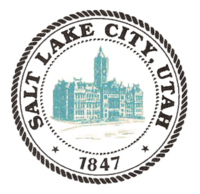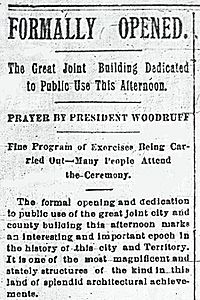Salt Lake City and County Building facts for kids
Quick facts for kids |
|
|
Salt Lake City and County Building
|
|

The Salt Lake City and County Building, seat of city government since 1894
|
|
| Location | 451 Washington Square, Salt Lake City, Utah |
|---|---|
| Area | 10 acres (4.0 ha) |
| Built | 1891–1894 |
| Architect | Bird & Monheim Proudfoot; W.S. Mills |
| Architectural style | Richardsonian Romanesque |
| NRHP reference No. | 70000629 |
| Added to NRHP | June 15, 1970 |
The Salt Lake City and County Building, often called the "City-County Building," is where the government of Salt Lake City, Utah, works. This important building used to hold offices for both the city and Salt Lake County. That's why it has "City and County" in its name!
Contents
Building History
The Salt Lake City and County Building was built between 1891 and 1894. It was designed to house offices for both the city and county governments. Before this building, the city and county used older courthouses built in the 1860s.
Planning and Construction Challenges
Building this landmark was not easy and caused a lot of debate. In the late 1800s, the City-County Building became a symbol for people who were not members of The Church of Jesus Christ of Latter-day Saints. They wanted it to be as grand as the Salt Lake Temple. Some even think its clock tower and statues were made to look like the temple's spires and the angel Moroni statue.
Surprisingly, the idea for the building first came from the "People's Party," which was supported by the Church. But when the "Liberal Party" (who were mostly not Church members) took control of the city government in 1890, they decided to go ahead with the project. Construction started in February 1891.
For a short time, construction stopped after only the foundation was laid. The city council, mostly made up of Liberal Party members, questioned the original plans. The Deseret News newspaper complained that the city was wasting money. Eventually, the plans and location were changed. The building was moved to its current spot at Washington Square. Construction on the new plans began in late 1891. The first stone was laid on July 25, 1892. The building was officially opened on December 28, 1894.
Architects and Costs
The architectural firm of Monheim, Bird, and Proudfoot designed the building in the Richardsonian Romanesque style. Henry Monheim, a local architect, teamed up with George W. Bird and Willis T. Proudfoot from Wichita, Kansas. They formed their company in 1891 just to design this building. Their design won a contest against fourteen other entries.
The building cost much more than expected. It was first estimated at $350,000, but by the time it was finished in 1894, it had cost almost $900,000! This was a big problem because the Panic of 1893 had cut Salt Lake City's money almost in half. Because of this, plans for large stained glass windows were canceled.
Past Uses of the Building
Today, only Salt Lake City government offices are in the building. But it used to serve many purposes. Salt Lake County offices were here until the 1980s.
The building also served as Utah's Capitol (the main government building) from 1896, when Utah became a state, until the current Utah State Capitol was finished in 1915. The City-County Building also housed Salt Lake's first public library. It had courtrooms, too.
Modern Renovations
From 1973 to 1989, the building went through a big renovation. Workers carefully repaired and restored it to look like it did originally. They also added a special earthquake protection system called base isolation. This system placed the building on a foundation of steel and rubber to help protect it from earthquake damage.
Building Features
The Salt Lake City and County Building has a tall central clock tower that reaches 256 feet (78 meters) high. On top of the tower is a statue of Columbia, a symbol of America. The building has large entrances on all four sides. On the south side, above the Mayor's office, there is a bronze statue of the goddess Justice.
The building's outside is covered in detailed carvings made from gray Utah Kyune sandstone. You can see many interesting faces and symbols carved into the stone.
- On the south side, you can find the face of Father DeSmet, a priest who met with Native Americans and Latter-day Saint pioneers.
- Next to him is Captain García López de Cárdenas, who explored Southern Utah in the 1500s.
- Above the columns on the east and west sides are carvings of pioneer women.
- Between the main entrance and balcony, you can see portraits of Chief Joseph, Chief Wakara, and Jim Bridger.
- The north side shows a scene from the Domínguez–Escalante expedition, which explored Utah in 1776.
- You can also spot Gargoyles, eagles, sea monsters, beehives, Masonic icons, suns, and other symbols all over the building's exterior.
Walter Baird and Oswald Lendi carved most of these features. Lendi, a French sculptor, even carved his own face between the words "City" and "Hall" above the north entrance!
The building has five floors and more than one hundred rooms. The hallways on each floor are decorated with beautiful Onyx stone. The mayor's office is on the third floor, along with the city council chambers. In the council meeting room, there is a large portrait of Brigham Young from 1865. Portraits of past mayors line the hallway. The third floor also has an exhibit about the 2002 Winter Olympics that were held in Salt Lake City.
Around the time of the 2002 Salt Lake Olympics, a display of the Olympic rings was shown on all four sides of the central tower. This display was only temporary and has since been removed.
Washington Square

The City-County Building is located in the center of a city block called "Washington Square." This block is between State Street, Second East, Fourth South, and Fifth South in Salt Lake City. It is named after George Washington. This block is also where the first Mormon pioneers set up camp in Salt Lake City in 1847.
Like other blocks in Salt Lake City's original layout, Washington Square is 10 acres (4.0 ha) large. The City-County Building is in the middle, surrounded by trees, walkways, and statues. This makes Washington Square feel like a small park. Many fairs, concerts, and other events are held here.
A very memorable event happened on June 16, 1995. About 50,000 people gathered on the west side of the building. They watched on large screens as the International Olympic Committee announced which city would host the 2002 Winter Olympics. When the chairman, Juan Antonio Samaranch, said "Salt Lake City," the crowd cheered so loudly that no one could hear the rest of his words! The square also hosted several concerts during the games. The final part of the Olympic torch relay started at Washington Square.
Many of Salt Lake City's cultural events take place at Washington Square. Sometimes, 200 East Street, which is between Washington Square and Library Square, is closed off to create one big event area. Events like the Utah Pride Festival, the Utah Arts Festival, the Salt Lake City Jazz Festival, and the Living Traditions Festival (which celebrates different cultures in Utah) happen here every year, usually on weekends.
Images for kids






